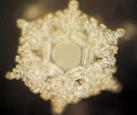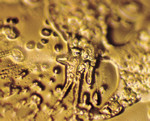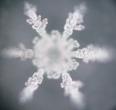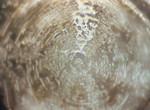

Masaru Emoto - Messages From Water
"You make me sick, I will kill
you!"
Compare this image with the
one below. Details are on the
left.
you!"
Compare this image with the
one below. Details are on the
left.
"Love and Thanks"
Compare this image with the
one above. Details are on the
left.
Compare this image with the
one above. Details are on the
left.
Please click here for the source of the water-crystal images. All
water-crystal images on this page are copyrighted and were reprinted
with written permission.
Masaru Emoto was born on July 22 1943, and graduated from
Yokohama Municipal University. Today he is known for his research on
water. His experiments include writing words on jars containing water
or "directing feelings" at the water, then he freezes the water and
photographs the resulting crystals.
You can see examples on the right - on one jar of water, the words
"You make me sick, I will kill you!" were written and "Love and Thanks"
were written on the other. As you can see, there's a very big difference
between the two images of the water crystals after water was frozen.
What does this mean? According to Dr. Emoto, water seems to have
"feelings". French scientist Jacques Benveniste, M.D., even published
a paper in 1988 about the idea of water having memory.
In his experiments, frozen water crystals which had been exposed to
positive thoughts, feelings, words and music formed different shapes
than water exposed to negative things. Even water from different
places around the world took different shapes when frozen.
For example, here are two images of the water crystals. The first was
exposed to classical music by Peter Tchaikovsky, "Swan Lake." The
second was exposed to heavy metal music:
Dr. Emoto acknowledges that he is not a scientist. His works have
been criticised for not following The Scientific Method (which you can
learn about, along with more on the subject here), He's also criticised
for not using Double Blind controls (his photographers and
experimenters are aware of the research being done - it is common
practice to not make these people aware of the research in order to
avoid any sort of bias). As well, Dr. Emoto admits that photographers
are told to only submit "the most pleasing photographs." Along with all
of this he's also been criticised for not using experimental controls
(isolating variables - making sure that things can't change and affect
experiments).
It's a known fact that humans are made up of mostly water (you can
learn more about that on this page). It's already been questioned that if
thoughts, feelings, etc., can affect water like this, then what can they
do to humans (and other species)?
Chances are, you're very skeptical of this. So am I - it's included in
this site because it's a new theory involving water. However, I decided
to conduct my own experiment. You can read more on this page.
To learn more about Dr. Emoto's work, there is a section on the
Links page where you can find many useful links about this subject
and others.
Please click here for the source of the water-crystal images. All
water-crystal images on this page are copyrighted and were reprinted
with written permission.
water-crystal images on this page are copyrighted and were reprinted
with written permission.
Masaru Emoto was born on July 22 1943, and graduated from
Yokohama Municipal University. Today he is known for his research on
water. His experiments include writing words on jars containing water
or "directing feelings" at the water, then he freezes the water and
photographs the resulting crystals.
You can see examples on the right - on one jar of water, the words
"You make me sick, I will kill you!" were written and "Love and Thanks"
were written on the other. As you can see, there's a very big difference
between the two images of the water crystals after water was frozen.
What does this mean? According to Dr. Emoto, water seems to have
"feelings". French scientist Jacques Benveniste, M.D., even published
a paper in 1988 about the idea of water having memory.
In his experiments, frozen water crystals which had been exposed to
positive thoughts, feelings, words and music formed different shapes
than water exposed to negative things. Even water from different
places around the world took different shapes when frozen.
For example, here are two images of the water crystals. The first was
exposed to classical music by Peter Tchaikovsky, "Swan Lake." The
second was exposed to heavy metal music:
Dr. Emoto acknowledges that he is not a scientist. His works have
been criticised for not following The Scientific Method (which you can
learn about, along with more on the subject here), He's also criticised
for not using Double Blind controls (his photographers and
experimenters are aware of the research being done - it is common
practice to not make these people aware of the research in order to
avoid any sort of bias). As well, Dr. Emoto admits that photographers
are told to only submit "the most pleasing photographs." Along with all
of this he's also been criticised for not using experimental controls
(isolating variables - making sure that things can't change and affect
experiments).
It's a known fact that humans are made up of mostly water (you can
learn more about that on this page). It's already been questioned that if
thoughts, feelings, etc., can affect water like this, then what can they
do to humans (and other species)?
Chances are, you're very skeptical of this. So am I - it's included in
this site because it's a new theory involving water. However, I decided
to conduct my own experiment. You can read more on this page.
To learn more about Dr. Emoto's work, there is a section on the
Links page where you can find many useful links about this subject
and others.
Please click here for the source of the water-crystal images. All
water-crystal images on this page are copyrighted and were reprinted
with written permission.
| Portal | Home | Information | QuickFacts | Links | Privacy © 2008-2010 H2O - CONTACT WEBMASTER REGARDING THIS SITE |
Click Here for images' source. All
water-crystal images on this page
are copyrighted and were reprinted
with written permission.
water-crystal images on this page
are copyrighted and were reprinted
with written permission.
| To learn more about how the water crystals are photographed, please watch this video. Video is provided by HadoLife |
|
Criticism
Conclusions, Experiment and Links




